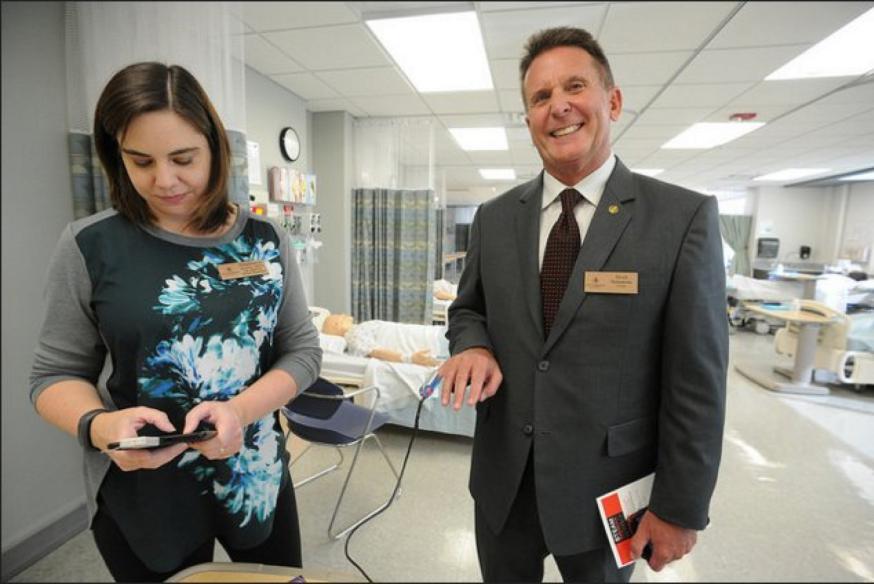
30 Aug Otterbein Nursing Experts and STEAM Center Startup Collaborate On Innovative Healthcare Simulation Solution
A patient lies on an examination table, pulse rate rising, body temperature showing fever, respiration rate increasing. The fully engaged medical professionals in attendance make assessments and take actions that could either remedy the situation – or possibly cause an even more critical problem to arise. But even if this particular patient does not survive today the case will have a tremendously successful outcome. Because this “patient” is not really sick at all – and the medical professionals providing treatment are nursing students who will have learned realistic lessons through one of the most effective training techniques available – healthcare simulation.
Healthcare simulation training itself is not new. In fact it has been growing enormously in popularity as the increased effectiveness of hands-on experiential learning continues to be proven. However, healthcare simulation training can be very costly. Simulation centers often require over $1 million dollars to build and hundreds of thousands of dollars annually to operate. Even a single high fidelity manikin can cost over $100,000. The high costs can limit the level of resources that educators can provide thus reducing the access and effectiveness for students.
 But the Otterbein Nursing Department Skills Laboratory team, led by experienced simulation professional Stephanie Justice, MSN, RN, had some ideas about how to address the problem. Much of the cost associated with healthcare simulation can be traced to the requirement for realism – for simulation professionals the term used is “high fidelity”. To learn most effectively, the students must actively perform the tasks involved in the simulation scenario and the results must reflect what would really happen with a patient. Lecturing or watching a video are not as effective for learning. People learn best by doing.
But the Otterbein Nursing Department Skills Laboratory team, led by experienced simulation professional Stephanie Justice, MSN, RN, had some ideas about how to address the problem. Much of the cost associated with healthcare simulation can be traced to the requirement for realism – for simulation professionals the term used is “high fidelity”. To learn most effectively, the students must actively perform the tasks involved in the simulation scenario and the results must reflect what would really happen with a patient. Lecturing or watching a video are not as effective for learning. People learn best by doing.
The traditional approach to “high fidelity” simulation has been to attempt to make manikins have more and more human like characteristics such as actual pulse rates and blood pressures. But that is where costs can skyrocket.
The Otterbein team recognized the possibility of a different approach. What if a manikin needed no actual body temperature or pulse rate at all – but instead the basic medical device measuring those vital signs could be simulated and controlled by an instructor to reflect whatever vital signs were needed? They reasoned that such “fake devices” would be much less costly than high fidelity manikins, plus they would be more flexible and therefore more accessible and useful to students.
The Nursing Department contacted the Otterbein Engineering Department, who subsequently engaged the help of edgeThingZ, a startup company and inaugural collaborator of the Otterbein STEAM Innovation Center. Within a few weeks the first prototypes of the simulation devices were being tested with Otterbein nursing students.
The result of the collaboration is a comparatively low cost set of tools called HESS – the Healthcare Education Simulation Station. HESS consists of realistic Pulse Oximeter, Thermometer and Capnometer devices that can simulate required key vital signs for a wide variety of healthcare simulation scenarios. The fact that HESS can work with less expensive low fidelity manikins – and even human actors – to create effective and highly realistic simulation scenarios greatly increases Otterbein’s ability to provide improved simulation training to more students cost effectively. edgeThingZ recently delivered multiple sets of HESS equipment to the Otterbein Nursing Department. Other nursing programs are now licensing the HE
SS solution as well.
Stephanie Justice comments that “The HESS is already improving our program and making our simulation training more effective at a lower cost. And we were amazed at how quickly things progressed in the STEAM Center environment from the idea to something usable. Not only do I love it but my students do too!”

A primary Otterbein STEAM Center goal of fostering collaboration between education and industry is quickly being realized.
“Partnering with businesses and subject matter experts in the STEAM Center to explore, test, invent and create new ideas like this to solve real world problems will offer hands-on experience to our students and lead to job creation and economic development for the state of Ohio” says Otterbein STEAM Center Director Erin Bender.
Jeff Becker of edgeThingZ says “To be able to access the expertise of the Otterbein Nursing Department during the collaboration was invaluable to a startup company like ours. Through their experienced eyes we were able to quickly understand the problem and create a solution.” He adds that “Beyond nursing schools we are already seeing interest from others such as EMT’s and hospitals that would like to run less expensive ‘in situ’ simulation as cost effective ongoing education for their clinical staff”.
It seems that it is “full STEAM ahead” at Otterbein University in Westerville, Ohio.






